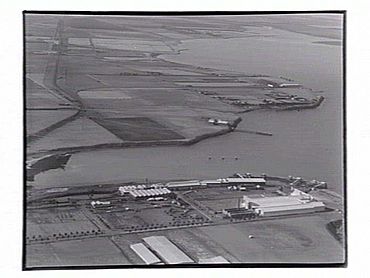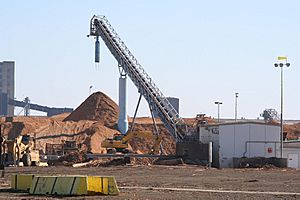North Shore, Victoria facts for kids
Quick facts for kids North ShoreGeelong, Victoria |
|||||||||||||||
|---|---|---|---|---|---|---|---|---|---|---|---|---|---|---|---|

North Shore in 1927. Corio Quay is in the foreground.
|
|||||||||||||||
| Population | 357 (2016 census) | ||||||||||||||
| • Density | 162/km2 (420/sq mi) | ||||||||||||||
| Postcode(s) | 3214 | ||||||||||||||
| Elevation | 16 m (52 ft) | ||||||||||||||
| Area | 2.2 km2 (0.8 sq mi) | ||||||||||||||
| Location | |||||||||||||||
| LGA(s) | City of Greater Geelong | ||||||||||||||
| State electorate(s) | Lara | ||||||||||||||
| Federal Division(s) | Corio | ||||||||||||||
|
|||||||||||||||
North Shore is a suburb in Geelong, Victoria, Australia. It has both factories and homes. This area looks out over Corio Bay. You'll find a small group of houses and some local shops near the North Shore railway station. The suburb is bordered by the Melbourne to Warrnambool railway line on one side. It also has borders with St Georges Road, Corio Bay, and Cowies Creek.
Contents
A Look Back: North Shore's History
North Shore was first planned as a place for homes and a nice spot by the bay. An esplanade (a long, open, level area by the sea) and a park were created. Trees were planted there. Today, only a small part of this park, called Moorpanyal Park, remains. A small jetty (a landing place for boats) was built. About 10 years later, North Shore became a small holiday spot.
Post Office and Railway Station History
The local Post Office opened on August 27, 1898. It was called Corio for a few years, from 1908 to 1913. Then, it changed back to North Shore.
The North Shore railway station has an interesting past. Some records say it first opened on April 15, 1895. However, an old map from 1857 shows a station named Cowie's Creek in the same spot. By the 1880s, this station was known as North Shore. In 1909, it was briefly renamed Corio, but it went back to North Shore in 1913.
In the 1920s, people suggested new names for the station. These names were linked to the growing factories in the area. Some ideas included Jelbart, Pivot, and Ford. In 1930, the Minister for Railways said the station would be called Pivot. But this change never happened.
Growth of Industry in North Shore
Factories started to appear in North Shore in 1899. A meat freezing works opened first. From 1909, the mouth of Cowies Creek was dug out to become Corio Quay. Later, Lascelles Wharf was built to the north.
In 1925, the Ford car factory opened. Also, the "Pivot" phosphate works, run by the Phosphate Co-Operative Company of Australia, started operating. In 1929, the Corio Distillery opened its doors. International Harvester built its plant near the Ford factory in 1939.
During the 1920s, new areas were divided up for housing in North Shore. One of these was called "Fordtown." This name likely tried to attract people because of the new Ford factory. The name was so well-known that it even appeared on an Army map in 1923. A small residential area slowly grew between the International Harvester plant and the Pivot works.
After World War II, more industries came to North Shore. The Shell Oil Company refinery began making products in 1956. Other companies that set up here included Coca-Cola Bottlers, Pilkington Glass, and Ryland Brothers. Ryland Brothers later became part of BHP and made wire products.
Sports and Community
The suburb has an Australian Rules football team. This team plays in the Geelong Football League.
Population Changes Over Time
Here's how the number of people living in North Shore has changed:
- 1921 - 124 people
- 1947 - 365 people
- 2021 - 325 people


